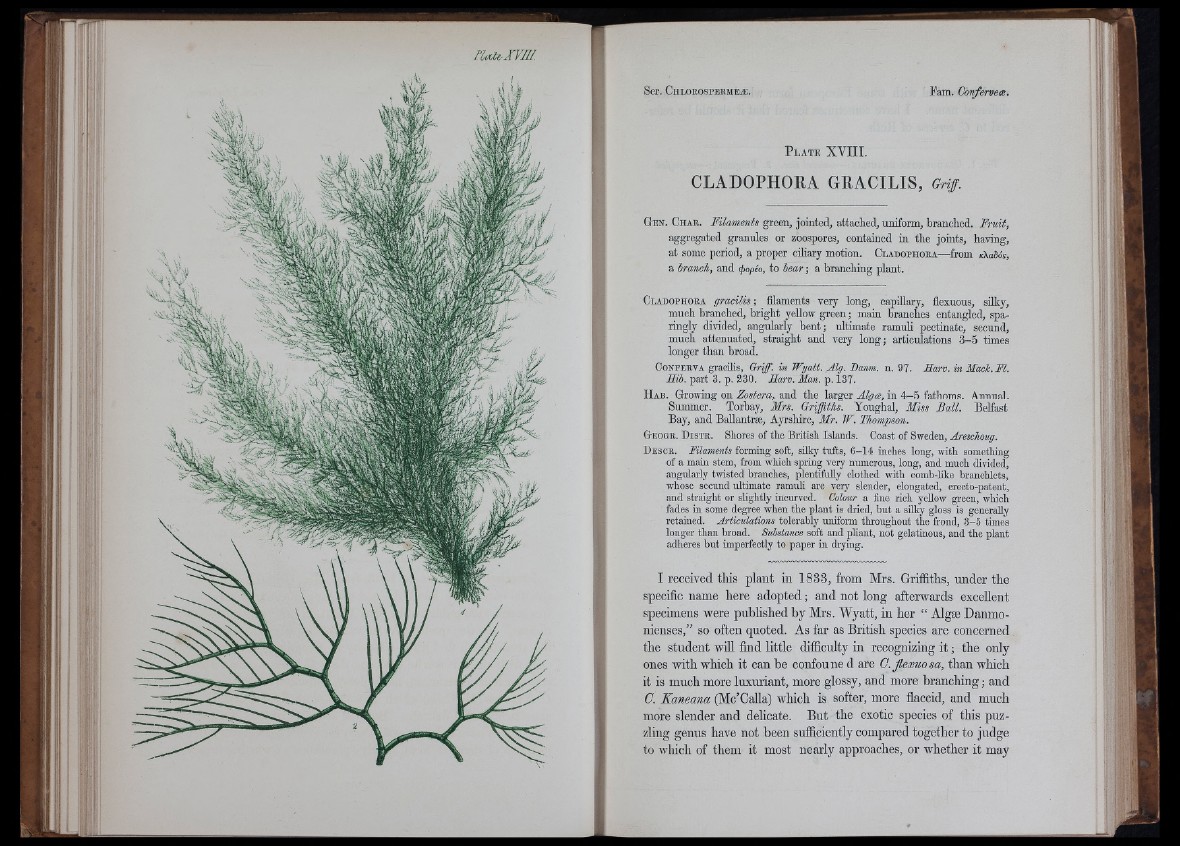
FùixZtJiVIII.
! ■
i !
:■ i i 'jii
i
P l a t e XVIII.
CLADOPHORA GRACILIS, Griff.
Gen. Char. Filaments green, jointed, attached, uniform, branched. Fruit,
aggregated granules or zoospores, contained in th e joints, having,
a t some period, a proper cihary motion. Cladophora— from kXoSo's,
a branch, and ^opco, to hear-, a branching plant.
Cladophora gracilis ; filaments very long, capillary, flexuous, shky,
much branched, bright yellow green ; main branches entangled, sparingly
divided, angularly ben t; ultimate ramuli pectinate, secund,
much attenuated, straight and very long; articulations 3 -5 times
longer than broad.
CoNPERTA gracilis. Griff, in Wyatt. Alg. Banm. n. 97. Harv. in Mack. FI.
Hib. part 3. p. 230. Harv. Man. p. 137.
H ab. Growing on Zostera, and the larger Alga, in 4 -6 fathoms. Annual.
Summer. Torbay, Mrs. Griffiths. Youghal, Miss Ba ll. Belfast
Bay, and BaUantree, Ayrshire, Mr. W. Thompson.
Ge o g r . D i s t r . Shores of the British Islands. Coast of Sweden, -
D e s c r . Filaments forming soft, silky tufts, 6-14 inches long, with something
of a main stem, from which spring very numerous, long, and much divided,
angularly twisted branches, plentifully clothed with comb-like branchlets,
whose seound ultimate ramuli are very slender, elongated, erecto-patent,
and straight or sUghtly incurved. Colour a fine rich yellow green, which
fades in some degree when the plant is dried, but a silky gloss is generally
retained. Articulations tolerably uniform throughout the frond, 3-5 times
longer than broad. Substance soft and pliant, not gelatinous, and the plant
adheres but imperfectly to paper in drying.
I received this plant in 1833, from Mrs. Griffiths, under the
specific name here adopted ; and not long afterwards excellent
specimens were published by Mrs. Wyatt, in her “ Algæ Danmo-
nienses,” so often quoted. As far as British species are concerned
the student will find little difficulty in recognizing it ; the only
ones with which it can be confoune d are C. flexuosa, than which
it is much more luxuriant, more glossy, and more branching ; and
C. Kaneana (Mo’Calla) which is softer, more flaccid, and much
more slender and delicate. But the exotic species of this puzzling
genus have not been sufficiently compared together to judge
to which of them it most nearly approaches, or whether it may